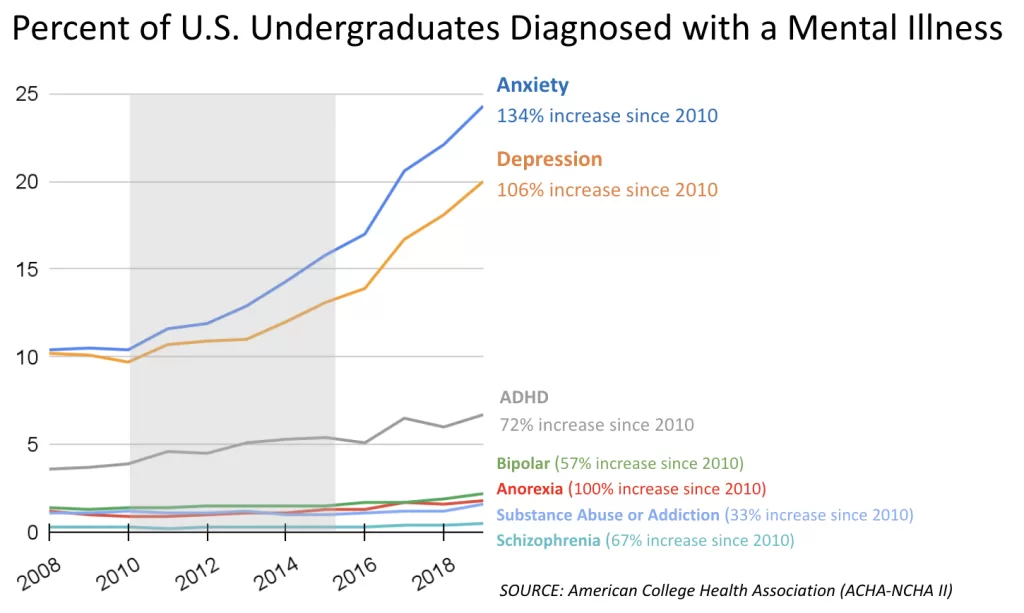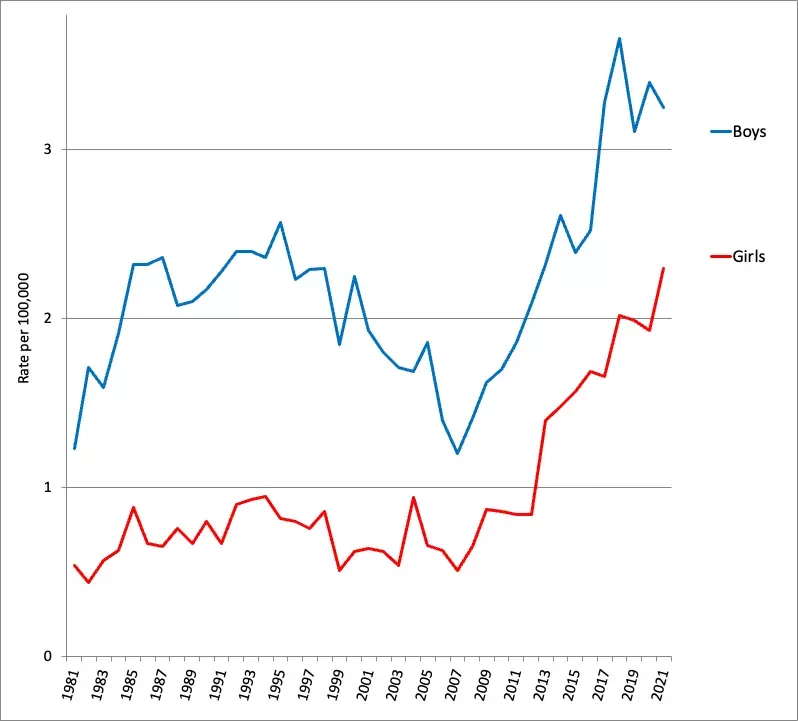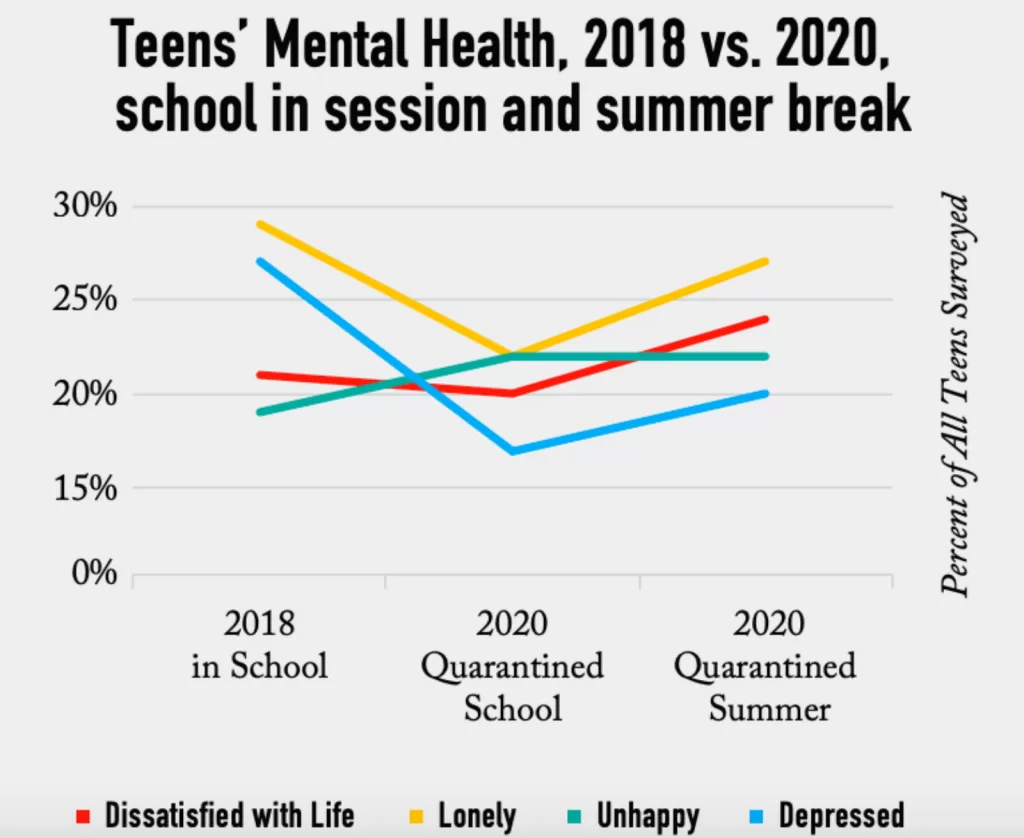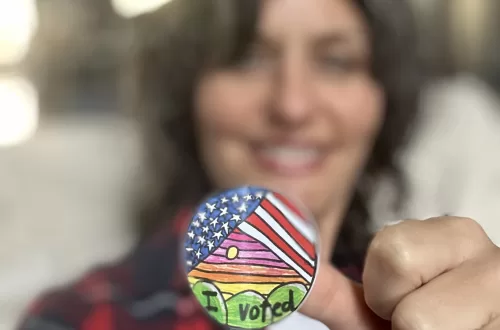Though there isn’t a specific moment that we can universally point to that marks the end of the COVID-19 pandemic, we all seem to have a milestone that captures when COVID-19 began. For most of us, last week marked the fifth anniversary of those experiences. My early memories of COVID were heavy with concerns for my four teenagers and the young people at my school who abruptly lost their in-person social connections and routines. Five years later, we have generally accepted the narrative that the pandemic lockdown caused significant emotional distress for teenagers and is partially to blame for today’s youth mental health crisis. But is that true?
Mental health outcomes worsened for young people after the pandemic, but that’s certainly not the whole story. Viewed through a slightly different lens, COVID lockdowns represent a brief, temporary, and positive interruption of a long-term decline in mental health that existed long before the pandemic and came back worse after lockdowns ended. That’s an important version of the story to consider since it might offer clues for how we can help support teens whose mental health continues to decline.
Teenagers during Pandemic Lockdowns
From March 2020 to May 2020, most states handled the pandemic similarly. Nearly all universities and K-12 schools (as well as most preschools) across the US closed. During the early stage of the pandemic lockdowns, our family–like many others–found a new, slower rhythm as we navigated school, work, church, and family life in greater proximity to our teens than we would be under “normal” circumstances. The house felt smaller as we sat around the living room talking after work and school ended each day. There wasn’t much else we could do. I forced the kids to join me on evening walks. Our most consistent weekly ritual was streaming our Sunday worship service from our kitchen table. When I talk about COVID with other moms with kids the same age as mine, many whisper as if they are trying to hide something shameful, “I loved that time with my kids.”
I understand the guilt they feel. It was a difficult time for many in the country. Many lost loved ones. Parents of young children felt acute stress as they navigated work and childcare simultaneously. Friends lost jobs. Anxiety went up for adults. But for many who stayed home with teenagers, this season seemed a little bit–dare I say–pleasant.
The Bigger Picture of Teen Mental Health Over Time
Youth mental health was on a pretty terrible trajectory long before COVID-19 existed. No social scientist has cataloged these trends more than Jean Twenge. No one has made her charts more popular than Jonathan Haidt. You can read their full breakdown here, but I’ve included some of their most compelling graphics below. The data clearly demonstrate a crisis of anxiety, depression, and self-harm that began to intensify somewhere between 2010-2012.


Unsurprisingly, those troubling statistics continued to grow after COVID lockdowns. So the reports about the mental health crisis after COVID weren’t false. But the teen mental health crisis was on that predictable trajectory long before COVID. Saying that mental health suffered because of the COVID lockdowns is trickier to prove. In fact, there’s some evidence that the COVID lockdowns were good for many teens.
What happened to teen mental health during the lockdowns?
A joint study between the Wheatley Institute and the Institute for Family Studies surveyed young people during COVID lockdowns. They asked the same questions the Monitoring Our Future survey asked teenagers in 2018 and compared the results. They found depression and loneliness were actually lower in the summer of 2020 than in 2018. Unhappiness and dissatisfaction with life were only slightly worse (see chart taken from the official report below). This “slightly worse” is especially notable when compared to adults’ mental health statistics which was three times worse during this same period. Other studies echoed these findings and the experiences I heard from many teen parents: COVID was not universally detrimental to teen mental health.

Strong parental connections created an invisible layer of protection around teens and young adults that not only limited the negative aspects of COVID, but also produced greater stability in the midst of it. Kids who reported close relationships with their parents had the lowest levels of loneliness during the pandemic and fewer mental health problems shortly after pandemic lockdowns–even after controlling for demographic factors such as gender, income, and race. One study found that teen girls specifically benefitted from reduced pressure from school activities and increased time for family connections. Repeatedly, strong parental relationships mitigated at least some of the stress COVID presented.
Parents contributed to teen mental health not only through relational closeness but also by facilitating strong, healthy routines. During the crisis, adults sought to create structure and their kids had no other real option than to benefit from the predictability it brought. Many teenagers developed better sleep habits and used technology to connect rather than to pass time. Teens who watched movies with their families or used social media to connect were better off than those who passively engaged with technology (think doomscrolling).
We presumed teens would be worse off during COVID in part because our culture tends to hyper-focus on the importance of peer relationships during the teen years. Certainly, adolescence is an important time for teens to learn how to integrate themselves into the community–which often leads to more of a herd mentality for teenagers. But it’s relationships with adults that predict mental health. Adolescents who have strong relationships with their parents have better mental health both in their teen years and into adulthood. Without these strong relationships, teens are in trouble (see one of many times psychologist Lisa Damour talked about this). Teens who said they were less lonely and depressed during COVID than the average response in 2018 also said they had grown closer to their parents and were talking to them more during lockdowns.
When the world slowed down enough to give kids a full night’s sleep and some forced quality time with their families, teenagers benefitted.
Not everyone did better
Of course, not every child experienced these benefits. Teens who already had mental health problems before COVID were most likely to suffer during lockdowns. Vulnerable teens lacked access to crucial supports and routine. Teens with severe special needs who rely on external support were not included in many of these studies.
Furthermore, the benefits of being home with parents were obviously limited to those who were indeed at home with their parents. Essential personnel and service workers could not stay home with their kids to set routines and share bonding experiences. Since nearly half of essential workers are also categorized as low-income, poorer children may have been disproportionately home alone without the close presence of an adult. Thus they may not have benefitted from the relational support or strong routines adults facilitated.
I don’t want to minimize these challenges. But even these negative outcomes tell a story worth paying attention to. Teens benefit from routines and from being around trusted adults. We should work to ensure everyone has access to that regardless of their circumstances. Some young people rely more on the broader community for those social supports and routines. As an educator, that informs my thinking on how I can better support the teens in my life both now and if a similar crisis returns.
What can we learn about teen mental health from COVID lockdowns?
I don’t want to revert to a lockdown state or idealize a crisis. Nor do I want to downplay the importance of community. But something happened during the lockdowns with teenagers that defied all of our expectations. During a generational crisis, at the point of greatest social isolation, many teens felt less lonely and depressed than they did before or after. And that is notable.
As parents, we are often highly concerned with our teens’ social connections and with controlling the circumstances around their lives. The constant news of the teen mental health crisis can create a hypervigilance about these things. But the temporary reprieve in loneliness and depression observed during lockdowns points to other factors that influence their well-being.
As parents, we underestimate our own impact in our teenagers’ lives. Though teens are (necessarily) growing in independence and the impact of their broader social network is increasing, we still have a significant role to play. The young adults in our lives need our gentle guidance and loving presence. Perhaps that’s something worthwhile we can take from the pandemic. I’m grateful for the return of school assemblies, basketball games, and community gatherings. But in the midst of them, we should find time for family dinners, forced walks, and allowing our kids to wake up with the sun as much as they can.






https://shorturl.fm/47rLb
https://shorturl.fm/JtG9d
https://shorturl.fm/TDuGJ
https://shorturl.fm/PFOiP
https://shorturl.fm/fSv4z
https://shorturl.fm/YZRz9
https://shorturl.fm/nqe5E
https://shorturl.fm/Xect5
https://shorturl.fm/PFOiP
https://shorturl.fm/I3T8M
https://shorturl.fm/LdPUr
https://shorturl.fm/retLL
https://shorturl.fm/YvSxU
https://shorturl.fm/oYjg5
https://shorturl.fm/bODKa
https://shorturl.fm/A5ni8
https://shorturl.fm/68Y8V
https://shorturl.fm/FIJkD
https://shorturl.fm/m8ueY
https://shorturl.fm/j3kEj
https://shorturl.fm/XIZGD
https://shorturl.fm/5JO3e
https://shorturl.fm/5JO3e
https://shorturl.fm/TbTre
https://shorturl.fm/oYjg5
https://shorturl.fm/FIJkD
https://shorturl.fm/6539m
https://shorturl.fm/9fnIC
https://shorturl.fm/j3kEj
Really appreciate the quality of content here. Always worth the read.
Area 52 becomes the first and only online dispensary to ship premium cannabis legally to all 50 states.
This breakthrough service follows their strict compliance with the
2018 Farm Bill, making quality weed available to everyone, regardless of local
laws.
“We’re the only company offering this nationwide shipping service for premium cannabis products,” said Area 52’s founder.
“While others can’t or won’t ship across state lines, we’ve found the legal path forward.”
Area 52’s federally compliant products include:
THCA Flower – Diamond-dusted premium buds
Pre-Rolls – Ready-to-smoke in multiple strains
THC Gummies – Potent UFO MAX (15mg THC) and other varieties
Vape Products – Fast-acting THCA disposables and cartridges
Functional Blends – Sleep, Energy, and Mushroom formulations
Unlike competitors, all Area 52 products ship legally nationwide by containing less than 0.3% Delta-9 THC while delivering
powerful effects.
“No other company can legally ship weed to all 50 states like we can,” the founder
emphasized. “This is a game-changer for people without local dispensary access.”
Every product includes a 60-day money-back guarantee and orders over $110 ship
free.
Want legal weed delivered to your door? Area 52 is the only online dispensary that can ship
to your state.